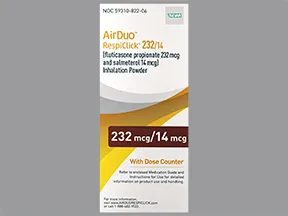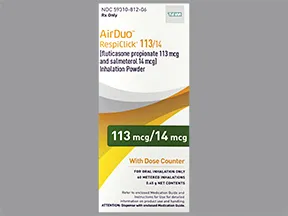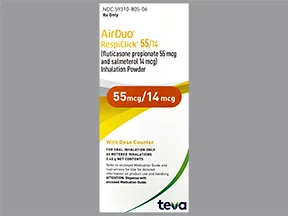Uses
This product is used to control and prevent symptoms (wheezing and shortness of breath) caused by asthma. It contains 2 medications: fluticasone and salmeterol. Fluticasone belongs to a class of drugs known as corticosteroids. It works by reducing the irritation and swelling of the airways. Salmeterol belongs to a class of drugs known as long-acting beta agonists. It works by relaxing the muscles around the airways so that they open up and you can breathe more easily. Controlling symptoms of breathing problems can decrease time lost from work or school.When used alone, long-acting beta agonists (such as salmeterol) may rarely increase the risk of serious (sometimes fatal) asthma-related breathing problems. However, combination inhaled corticosteroid and long-acting beta agonists, such as this product, do not increase the risk of serious asthma-related breathing problems. This product should be used when breathing problems are not well controlled with one asthma-control medication (such as inhaled corticosteroid) or if your symptoms need combination treatment.Before using this medication, it is important to learn how to use it properly. This medication must be used regularly to be effective. It does not work right away and should not be used to relieve sudden asthma attacks. If an asthma attack occurs, use your quick-relief inhaler (such as albuterol, also called salbutamol in some countries) as prescribed.
How to use Airduo Respiclick 232 Mcg-14 Mcg/Actuation Breath Activated
Read the Patient Information Leaflet and Instructions for Use provided by your pharmacist before you start using this medication and each time you get a refill. Follow the illustrated directions for the proper use of this medication. If you have any questions, ask your doctor or pharmacist.
Make sure the cap is closed before you start using your inhaler. Hold the inhaler upright and open the cap until it "clicks." Inhale this medication by mouth as directed by your doctor, usually twice daily (in the morning and evening, 12 hours apart). You may or may not taste/feel the drug when you inhale. Either is normal. Do not exhale into the device. Close the cap firmly after each use.
Do not take the inhaler apart or wash the mouthpiece or any part of the device. Do not open the cap unless you are ready for your next dose.
If you are using other inhalers at the same time, wait at least 1 minute between the use of each medication, and use this drug last.
To prevent dry mouth, hoarseness, and oral yeast infections from developing, gargle, rinse your mouth with water and spit out after each use. Do not swallow the rinse water.
The dosage is based on your medical condition and response to treatment.
Use this medication regularly to get the most benefit from it. This medication works best if used at evenly spaced times. To help you remember, use it at the same times each day. Do not increase your dose, use this product more often, or stop using it without talking with your doctor. Also, do not use other long-acting beta agonists while using this medication.
If you have been using a quick-relief inhaler (such as albuterol, also called salbutamol in some countries) on a regular daily schedule (such as 4 times daily), you must stop this schedule and only use the quick-relief inhaler as needed for sudden shortness of breath/asthma attacks. Consult your doctor for details.
If you are regularly taking a different corticosteroid by mouth (such as prednisone), you should not stop taking it unless directed by your doctor. Some conditions (such as asthma, allergies) may become worse when the drug is suddenly stopped. If you suddenly stop taking the drug, you may also have withdrawal symptoms (such as weakness, weight loss, nausea, muscle pain, headache, tiredness, dizziness). To help prevent withdrawal, your doctor may slowly lower the dose of your old medication after you begin using fluticasone/salmeterol. Tell your doctor or pharmacist right away if you have withdrawal. See also Precautions section.
It may take 1 week or longer before you get the full benefit of this drug.
Learn which of your inhalers you should use every day (controller drugs) and which you should use if your breathing suddenly worsens (quick-relief drugs). Ask your doctor ahead of time what you should do if you have new or worsening cough or shortness of breath, wheezing, increased sputum, worsening peak flow meter readings, waking up at night with trouble breathing, if you use your quick-relief inhaler more often (more than 2 days a week), or if your quick-relief inhaler does not seem to be working well. Learn when you can treat sudden breathing problems by yourself and when you must get medical help right away.
Tell your doctor if you do not get better or if you get worse.
Side Effects
See also Precautions section.
Hoarseness, dry/irritated throat, or headache may occur. If any of these effects last or get worse, tell your doctor or pharmacist promptly.
Remember that this medication has been prescribed because your doctor has judged that the benefit to you is greater than the risk of side effects. Many people using this medication do not have serious side effects.
This medication may raise your blood pressure. Check your blood pressure regularly and tell your doctor if the results are high.
Rarely, this medication may cause sudden breathing problems/asthma right after you use it. If this occurs, use your quick-relief inhaler and get medical help right away.
Tell your doctor right away if you have any serious side effects, including: white patches on tongue/in mouth, signs of infection (such as sore throat that doesn't go away, fever), mental/mood changes (such as nervousness), trouble sleeping, vision problems (such as blurred vision), increased thirst/urination, muscle cramps, shaking (tremors).
Get medical help right away if you have any very serious side effects, including: chest pain, fast/irregular heartbeat, severe dizziness, fainting, seizures.
A very serious allergic reaction to this product is rare. However, get medical help right away if you notice any symptoms of a serious allergic reaction, including: rash, itching/swelling (especially of the face/tongue/throat), severe dizziness, trouble breathing.
This is not a complete list of possible side effects. If you notice other effects not listed above, contact your doctor or pharmacist.
In the US -
Call your doctor for medical advice about side effects. You may report side effects to FDA at 1-800-FDA-1088 or at www.fda.gov/medwatch.
In Canada - Call your doctor for medical advice about side effects. You may report side effects to Health Canada at 1-866-234-2345.
Precautions
Before using this product, tell your doctor or pharmacist if you are allergic to fluticasone or salmeterol; or if you have any other allergies. This product may contain inactive ingredients (such as lactose, milk proteins), which can cause allergic reactions or other problems. Talk to your pharmacist for more details.
Before using this medication, tell your doctor or pharmacist your medical history, especially of: current/past infections (such as tuberculosis, herpes), high blood pressure, bone loss (osteoporosis), heart disease (such as chest pain, heart attack, irregular heartbeat), overactive thyroid (hyperthyroidism), diabetes, eye problems (such as cataracts, glaucoma), seizures, liver disease.
Salmeterol may cause a condition that affects the heart rhythm (QT prolongation). QT prolongation can rarely cause serious (rarely fatal) fast/irregular heartbeat and other symptoms (such as severe dizziness, fainting) that need medical attention right away.
The risk of QT prolongation may be increased if you have certain medical conditions or are taking other drugs that may cause QT prolongation. Before using this product, tell your doctor or pharmacist of all the drugs you take and if you have any of the following conditions: certain heart problems (heart failure, slow heartbeat, QT prolongation in the EKG), family history of certain heart problems (QT prolongation in the EKG, sudden cardiac death).
Low levels of potassium or magnesium in the blood may also increase your risk of QT prolongation. This risk may increase if you use certain drugs (such as diuretics/"water pills") or if you have conditions such as severe sweating, diarrhea, or vomiting. Talk to your doctor about using this medication safely.
This medication may mask signs of infection. It can make you more likely to get infections or may make current infections worse. Stay away from anyone who has an infection that may easily spread (such as chickenpox, COVID-19, measles, flu). Talk to your doctor if you have been exposed to an infection or for more details.
If you have switched from a corticosteroid taken by mouth (such as prednisone tablets) to this inhaler within the past 12 months, or if you have been using this product in higher-than-usual doses for a long time, it may be more difficult for your body to respond to physical stress. Before having surgery or emergency treatment, or if you get a serious illness/injury, tell your doctor or dentist that you are using this medication or have used a corticosteroid taken by mouth within the past 12 months. Tell your doctor right away if you develop unusual/extreme tiredness or weight loss. Carry a warning card or medical ID bracelet that says you use (or have used) corticosteroid medications.
Before having surgery, tell your doctor or dentist about all the products you use (including prescription drugs, nonprescription drugs, and herbal products).
Older adults with COPD may be at greater risk for pneumonia while using this drug. Older adults may also be more sensitive to the side effects of this drug, especially QT prolongation (see above).
This medication may temporarily slow down a child's growth if used for a long time. However, poorly controlled asthma can also slow down growth. See the doctor regularly so your child's height can be checked.
During pregnancy, this medication should be used only when clearly needed. Discuss the risks and benefits with your doctor.
It is unknown if this medication passes into breast milk. Consult your doctor before breastfeeding.
Interactions
Drug interactions may change how your medications work or increase your risk for serious side effects. This document does not contain all possible drug interactions. Keep a list of all the products you use (including prescription/nonprescription drugs and herbal products) and share it with your doctor and pharmacist. Do not start, stop, or change the dosage of any medicines without your doctor's approval.
Some products that may interact with this drug include: aldesleukin, desmopressin.
Other medications can affect the removal of fluticasone and salmeterol from your body, which may affect how this product works. Examples include azole antifungals (such as ketoconazole), cobicistat, macrolide antibiotics (such as clarithromycin), HIV protease inhibitors (such as lopinavir), nefazodone, ritonavir, telithromycin, among others.
Overdose
If someone has overdosed and has serious symptoms such as passing out or trouble breathing, call 911. Otherwise, call a poison control center right away. US residents can call 1-800-222-1222. Canada residents can call 1-844-764-7669. Symptoms of overdose may include: shaking (tremors), chest pain, fast/irregular heartbeat, seizures.
Do not share this medication with others.
Lab and/or medical tests (such as lung function, blood pressure, bone density tests, eye exams) may be done while you are using this medication. Keep all medical and lab appointments.
Avoid substances that can worsen breathing problems by causing irritation or allergic reaction, such as smoke, pollen, pet dander, dust, and mold.
Learn to use a peak flow meter, use it daily, and promptly report worsening breathing problems (such as readings in the yellow/red range, increased use of quick-relief inhalers).
Because the flu virus can worsen breathing problems, ask your doctor or pharmacist if you should have a flu shot every year.
In adults, this medication can increase the risk of bone loss (osteoporosis) if used for a long time. Talk with your doctor about your risk, and about available treatments for osteoporosis. Lifestyle changes that help promote healthy bones include increasing weight-bearing exercise, stopping smoking, limiting alcohol, and eating well-balanced meals that contain adequate calcium and vitamin D. You may also need to take calcium and vitamin D supplements. To help prevent osteoporosis later in life, encourage children to exercise and eat a healthy diet (including calcium).
If you miss a dose, skip the missed dose. Use your next dose at the regular time. Do not double the dose to catch up.
Store at room temperature away from light and moisture. Do not store in the bathroom. Keep all medications away from children and pets.
Do not remove the device from its original foil package until ready to use. Discard the device 1 month after you remove it from the original foil package or after all the doses have been used, whichever comes first.
Do not flush medications down the toilet or pour them into a drain unless instructed to do so. Properly discard this product when it is expired or no longer needed. Consult your pharmacist or local waste disposal company.
Images

AirDuo RespiClick 232 mcg-14 mcg/actuation breath activated
Color: whiteShape: Imprint:This medicine is a white, aerosol

AirDuo RespiClick 113 mcg-14 mcg/actuation breath activated
Color: whiteShape: Imprint:This medicine is a white, aerosol

AirDuo RespiClick 55 mcg-14 mcg/actuation breath activated
Color: whiteShape: Imprint:This medicine is a white, aerosol
Are you currently using Airduo Respiclick 232 Mcg-14 Mcg/Actuation Breath Activated?
This survey is being conducted by the WebMD marketing sciences department.
Selected from data included with permission and copyrighted by First Databank, Inc. This copyrighted material has been downloaded from a licensed data provider and is not for distribution, except as may be authorized by the applicable terms of use.
CONDITIONS OF USE: The information in this database is intended to supplement, not substitute for, the expertise and judgment of healthcare professionals. The information is not intended to cover all possible uses, directions, precautions, drug interactions or adverse effects, nor should it be construed to indicate that use of a particular drug is safe, appropriate or effective for you or anyone else. A healthcare professional should be consulted before taking any drug, changing any diet or commencing or discontinuing any course of treatment.